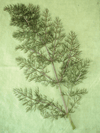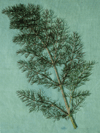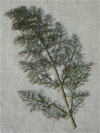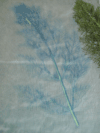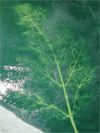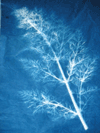
Please read all instructions before opening bag
NOTE: These instructions apply to treated paper as well as fabric!
Use within 6 months for best printing results (bright blues and good contrast).
When you open the black bag,the white fabric or paper will appear yellow/green or greyish blue depending on what material you are using. (The colored fabrics will look like a dulled version of the color). The final blue color will not be visible until the material has been exposed, rinsed and dried The fabrics are fully treated which means both sides have the cyanotype chemicals and you can print on either side. The paper has been .coated on one side only so print your design on the side that is a green/blue color. PRACTICE on a small sample piece of fabric first to get used to the process. Please do not attempt printing a large piece until you have practiced with a small piece first!
CALL IF YOU HAVE ANY QUESTIONS!
***** Important Care Instructions *****
• Blueprints are photographs – not dyes.
• The image is permanent, but the blue color will change to yellow if washed with phosphates, soda, borax or bleach.
• To preserve the original blue color – hand wash using only a small amount of NON-PHOSPHATE liquid soap. Rinse thoroughly and dry flat.
• Dry cleaning is NOT recommended.
• Blueprints can be ironed using a dry iron. The blue will change slightly while warm and return to the original color when cool.
Tips for Printing
Almost anything can be used to create an image. Keep in mind that whatever is covered and does not receive exposure to uv light will remain the color of the fabric or paper after exposure and rinsing with water. Only the uncovered areas will receive the uv light and will turn blue after exposure and rinsing with water. The more opaque the object is - the better it will block the uv light exposure and a very transparent object will allow some uv light through and will allow the material to slightly expose. You can create photo negatives by printing or drawing images on clear transparency sheets. You will lay the transparency sheet on the piece of paper or fabric and then place a piece of non uv blocking glass or acrylic on top of the transparency to hold the transparency in tight contact with the treated fabric or paper.
Do not get fabric wet before or during exposure. Make sure your hands are dry before handling the fabric. Also be sure that what you place on the fabric (and what you place the fabric on) to expose is dry.
****Practice on a small sample piece of fabric first to get used to the process. Fabric will be yellow-green when unexposed. The final blue color will not be visible until the fabric has been printed, rinsed and dried. Design blueprints using almost anything, leaves, lace, toys, confetti, drawings on acetate transparencies, old glass negatives....
Unexposed fabric CAN be ironed before exposure. Use a DRY iron that does not spit or leak water. Use a cotton or silk setting (depending on fabric to be ironed). Iron on wrong side of fabric and/or use a pressing cloth.
A small amount of 3% Hydrogen Peroxide (1 teaspoon H.P. to one gallon water) can be used in the first rinse water. This will cause the blue color to immediately deepen to it's final color.
RINSE FABRIC THOROUGHLY and DRY OUT OF DIRECT SUNLIGHT!
- TIPS AND TRICKS FOR PRINTING SPECIALTY FABRICS
Please read through all instructions and try a sample piece first and then try it again until you are sure that you know what you are doing. Contact us with any issues or questions before proceeding!
Thicker fabrics require a bit more practice. Canvas is thick and stiff. Velvet and velveteen have a nap that absorbs a lot of chemistry. Slightly overexposing your print on these fabrics allows the uv light to penetrate the layers of the nap and thickness and will generally allow a deeper, clearer print. Extra rinsing is required with these fabrics. Rinse and soak in warm water until the water is clear - then soak in warm water for 5 minutes and make sure that the water is clear - if not continue soaking and rinsing until all excess chemistry is removed. Lay flat on a clean towel to dry or hang to dry. Do not dry in the sun. After print is completely dry - it is OK to be out in the sun again. If any brown spots develop - just rinse in warm water until clear.
Have fun!
Use within 6 months (silks and paper) and 12 months (cottons) for best printing results (bright blues and good contrast).
Store extra fabric in sealed black plastic bag in a cool, dry place.
PLEASE NOTE: The fabric or paper will tend to darken over time even when sealed in black bag - do not assume that fabric or paper is expired - give it a try - sometimes all that is needed is a longer rinse in hot water after exposure.
Trouble Shooting
| • Blurry prints: This is a contact printing process. Transparencies and negatives must be firmly in contact with the fabric. Pin carefully, or use a piece of heavy glass to press design elements to fabric. Board must be perpendicular to the sun for even exposure. Printing in cloudy weather does not provide distinct shadows • Water spots: Caused by wet hands or wet leaves dripping on the fabric or paper before or during the process. • Streaks: Brown on back of print, dark line on front. Fabric or paper not well rinsed. Rinse again immediately. |
• Dark blue prints: Black areas of transparencies not dense enough, too little toner or ink. Too long in the sun, reduce exposure time. Not well rinsed, and print continues to expose. • Very pale blue: Hazy, cloudy weather, very cold, pale winter sun, too little exposure. • Surprise prints: Remove ravels, pins and extra items from board before printing. • No print: The glass or plastic cover piece has UV blocking. |
MATERIAL SAFETY DATA SHEETS FOR CYANOTYPE CHEMICALS
POTASSIUM FERRICYANIDE
============= Composition/Information on Ingredients ============= Ingred Name:POTASSIUM FERRICYANIDE CAS:13746-66-2 RTECS #:LJ8225000 = Wt:100. ===================== Hazards Identification ===================== LD50 LC50 Mixture:LD50 (ORAL, RAT) 2263 MG/KG Reports of Carcinogenicity:NTP:NO IARC:NO OSHA:NO Health Hazards Acute and Chronic:EFFECTS OF EXPOSURE: INHALATION: EXPECTED TO BE A LOW HAZARD FOR RECOMMENDED HANDLING. IF CYANIDE GAS IS LIBERATED DUE TO CONTACT WITH A STRONG ACID, IT MAY CAUSE DIZZINESS, HEADACHE, RAPID RESPIRATIO N, RAPID PULSE, UNCONSIOUSNESS, CONVULSIONS AND DEATH. EYES: CAUSES IRRITATION. HOWEVER, IMMEDIATE FLUSHING OF THE EYES WITH WATER WILL MINIMIZE ANY IRRITATIVE EFFECT. SKIN: LOW HAZARD FOR RECOMMENDED HANDLING. INGESTION: EXPECTED TO BE A LOW INGESTION HAZARD. Explanation of Carcinogenicity:CARCINOGENICITY CLASSIFICATION (COMPONENTS PRESENT AT 0.1% OR MORE): - AMERICAN CONFERENCE OF GOVERNMENTAL INDUSTRIAL HYGIENISTS (ACGIH): NONE - INTERNATIONAL AGENCY FOR RESEARCH ON CANCER (IARC): NON E - NATIONAL TOXICOLOGY PROGRAM (NTP): NONE - OCCUPATIONAL SAFETY AND HEALTH ADMINISTRATION (OSHA): NONE Effects of Overexposure:INHALATION: IF CYANIDE GAS IS LIBERATED DUE TO CONTACT WITH A STRONG ACID, IT MAY CAUSE DIZZINESS, HEADACHE, RAPID RESPIRATION, RAPID PULSE, UNCONSIOUSNESS, CONVULSIONS AND DEATH. EYES: CAUSES IRRITAT ION. Medical Cond Aggravated by Exposure:NOT PROVIDED. ======================= First Aid Measures ======================= First Aid:INHALATION: IF SYMPTOMATIC, MOVE TO FRESH AIR. TREAT SYMPTOMATICALLY. GET MEDICAL ATTENTION IF SYMPTOMS PERSIST. EYES: IMMEDIATELY FLUSH WITH PLENTY OF WATER FOR AT LEAST 15 MINUTES. GET MEDICAL ATTEN TION IF SYMPTOMS PERSIST. SKIN: WASH WITH SOAP AND WATER. GET MEDICAL ATTENTION IF SYMPTOMS OCCUR. INGESTION: DRINK 1-2 GLASSES OF WATER. SEEK MEDICAL ATTENTION. NEVER GIVE ANYTHING BY MOUTH TO AN UN CONSCIOUS PERSON. ===================== Fire Fighting Measures ===================== Extinguishing Media:WATER SPRAY, CARBON DIOXIDE (CO2), DRY CHEMICAL Fire Fighting Procedures:WEAR SELF-CONTAINED BREATHING APPARATUS AND PROTECTIVE CLOTHING. FIRE OR EXCESSIVE HEAT MAY PRODUCE HAZARDOUS DECOMPOSITION PRODUCTS. Unusual Fire/Explosion Hazard:POWDERED MATERIAL MAY FORM EXPLOSIVE DUST-AIR MIXTURES. FIRE OR HIGH TEMPERATURES MAY CAUSE DECOMPOSITION. ================== Accidental Release Measures ================== Spill Release Procedures:COLLECT UP AND PUT IN A SUITABLE CONTAINER. AVOID GENERATING DUST. CLEAN SURFACE THOROUGHLY TO REMOVE RESIDUAL CONTAMINATION. Neutralizing Agent:NOT PROVIDED. ====================== Handling and Storage ====================== Handling and Storage Precautions:KEEP CONTAINER TIGHTLY CLOSED. KEEP AWAY FROM INCOMPATIBLE SUBSTANCES (SEE INCOMPATIBILITY SECTION). KEEP FROM CONTACT WITH OXIDIZING MATERIALS. KEEP AWAY FROM HEAT. POWDERED MATERIAL MAY FORM EXPLOSI VE DUST-AIR MIXTURES. MINIMIZE DUST GENERATION AND ACCUMULATION. KEEP AWAY FROM SOURCES OF IGNITION. Other Precautions:AVOID PROLONGED OR REPEATED BREATHING OF DUST. AVOID CONTACT WITH EYES AND PROLONGED OR REPEATED CONTACT WITH SKIN. USE WITH ADEQUATE VENTILATION. WASH THOROUGHLY AFTER HANDLING. ============= Exposure Controls/Personal Protection ============= Respiratory Protection:NONE SHOULD BE NEEDED. A FULL-FACE POSITIVE-PRESSURE AIR-SUPPLIED RESPIRATOR MUST BE WORN IF HAZARDOUS DECOMPOSITION PRODUCTS ARE LIKELY TO BE RELEASED OR HAVE BEEN RELEASED. SEE STABILITY AND REACTIV ITY SECTION. IF RESPIRATORS ARE USED, A PROGRAM SHOULD BE INSTITUTED TO ASSURE COMPLIANCE WITH OSHA STANDARD 29 CFR 1910.134. Ventilation:GOOD GENERAL VENTILATION (TYPICALLY 10 AIR CHANGES PER HOUR) SHOULD BE USED. VENTILATION RATES SHOULD BE MATCHED TO CONDITIONS. Protective Gloves:WEAR IMPERVIOUS GLOVES AND PROTECTIVE CLOTHING APPROPRIATE FOR RISK OF EXPOSURE Eye Protection:WEAR SAFETY GLASSES WITH SIDE SHIELDS (OR GOGGLES). Other Protective Equipment:EYE BATH, WASHING FACILITIES, SAFETY SHOWER Work Hygienic Practices:NOT PROVIDED Supplemental Safety and Health SUPPLEMENTARY LOCAL EXHAUST VENTILATION, CLOSED SYSTEMS, OR RESPIRATORY PROTECTION MAY BE NEEDED IN SPECIAL CIRCUMSTANCES SUCH AS POORLY VENTILATED SPACES, MECHANICAL GENERATION OF DUSTS, HEATING, DR YING, ETC. ================== Physical/Chemical Properties ================== HCC:N1 NRC/State Lic Num:NOT RELEVANT. Boiling Pt:B.P. Text:NOT RELEVANT. Melt/Freeze Pt:M.P/F.P Text:DECOMPOSES Decomp Temp:Decomp Text:NOT PROVIDED Vapor Pres:NEGLIGIBLE Spec Gravity:1.89 Solubility in Water:APPRECIABLE Appearance and Odor:RED SOLID - ODORLESS Percent Volatiles by Volume:NEGLIGIBLE Corrosion Rate:NOT PROVIDED ================= Stability and Reactivity Data ================= Stability Indicator/Materials to Avoid:YES STRONG OXIDIZING AGENTS, STRONG ACIDS. CONTACT WITH ACID LIBERATES FLAMMABLE MATERIAL, TOXIC GAS. Stability Condition to Avoid:STABLE. NO EXOTHERM TO: 310C BY HPDSC Hazardous Decomposition Products:CARBON DIOXIDE, CARBON MONOXIDE, OXIDES OF NITROGEN, CYANIDES. =================== Toxicological Information =================== Toxicological Information:ACUTE TOXICITY DATA: ORAL LD-50 (RAT): 2263 MG/KG DERMAL LD-50: 1 G/KG EYE IRRITATION (UNWASHED EYES): MODERATE EYE IRRITATION (WASHED EYES): SLIGHT SKIN IRRITATION: SLIGHT ===================== Ecological Information ===================== Ecological:POTENTIAL TOXICITY: FISH LC50 MG/L: >100. DAPHNID EC50 MG/L: 1-10. ALGAL IC50 MG/L: NOT AVAILABLE. ORGANICS READILY DEGRADABLE (>70%): NOT APPLICABLE. POTENTIAL BIOACCUMULATION: LOG POW
FERRIC AMMONIUM CITRATE
1. Product Identification
Synonyms: Citric acid, ammonium iron (3+) salt; ammonium ferric citrate; 1,2,3-propanetricarboxylic acid,2-hydroxy-,ammonium iron (3+) salt; Ferric ammonium citrate, Brown; Ferric ammonium citrate, Green
CAS No.: 1185-57-5
Molecular Weight: Not applicable to mixtures.
Chemical Formula: C6H8O7.xFe.xNH3
Product Codes: 1977, 1980
2. Composition/Information on Ingredients
Ingredient CAS No Percent Hazardous --------------------------------------- ------------ ------------ --------- Ferric Ammonium Citrate 1185-57-5 90 - 100% Yes
3. Hazards Identification
Emergency Overview
--------------------------
CAUTION! MAY BE HARMFUL IF SWALLOWED. MAY CAUSE IRRITATION TO SKIN, EYES, AND RESPIRATORY TRACT.
SAF-T-DATA(tm) Ratings (Provided here for your convenience)
-----------------------------------------------------------------------------------------------------------
Health Rating: 3 - Severe (Life)
Flammability Rating: 1 - Slight
Reactivity Rating: 1 - Slight
Contact Rating: 1 - Slight
Lab Protective Equip: GOGGLES; LAB COAT; VENT HOOD; PROPER GLOVES
Storage Color Code: Green (General Storage)
-----------------------------------------------------------------------------------------------------------
Potential Health Effects
----------------------------------
Inhalation:
Inhalation of dust may cause irritation to the upper respiratory tract.
Ingestion:
Low toxicity in small quantities but larger dosages may cause nausea, vomiting, diarrhea, and black stool. Pink urine discoloration is a strong indicator of iron poisoning. Liver damage, coma, and death from iron poisoning has been recorded.
Skin Contact:
Mild irritant to skin due to acidic nature of ferric salts.
Eye Contact:
Mild irritant due to acidic nature of ferric salts.
Chronic Exposure:
No information found.
Aggravation of Pre-existing Conditions:
Persons with pre-existing skin disorders or eye problems, or impaired liver, kidney or respiratory function may be more susceptible to the effects of the substance.
4. First Aid Measures
Inhalation:
Remove to fresh air. Get medical attention for any breathing difficulty.
Ingestion:
Induce vomiting immediately as directed by medical personnel. Never give anything by mouth to an unconscious person.
Skin Contact:
Wash exposed area with soap and water. Get medical advice if irritation develops.
Eye Contact:
Wash thoroughly with running water. Get medical advice if irritation develops.
5. Fire Fighting Measures
Fire:
As with most organic solids, fire is possible at elevated temperatures or by contact with an ignition source.
Explosion:
Not considered to be an explosion hazard.
Fire Extinguishing Media:
Use any means suitable for extinguishing surrounding fire.
Special Information:
In the event of a fire, wear full protective clothing and NIOSH-approved self-contained breathing apparatus with full facepiece operated in the pressure demand or other positive pressure mode.
6. Accidental Release Measures
Remove all sources of ignition. Ventilate area of leak or spill. Wear appropriate personal protective equipment as specified in Section 8. Spills: Clean up spills in a manner that does not disperse dust into the air. Use non-sparking tools and equipment. Reduce airborne dust and prevent scattering by moistening with water. Pick up spill for recovery or disposal and place in a closed container.
7. Handling and Storage
Keep in a tightly closed container, stored in a cool, dry, ventilated area. Protect against physical damage. Protect from light. Containers of this material may be hazardous when empty since they retain product residues (dust, solids); observe all warnings and precautions listed for the product.
8. Exposure Controls/Personal Protection
Airborne Exposure Limits:
-ACGIH Threshold Limit Value (TLV):
1 mg/m3 (TWA) soluble iron salt as Fe
Ventilation System:
A system of local and/or general exhaust is recommended to keep employee exposures below the Airborne Exposure Limits. Local exhaust ventilation is generally preferred because it can control the emissions of the contaminant at its source, preventing dispersion of it into the general work area. Please refer to the ACGIH document, Industrial Ventilation, A Manual of Recommended Practices, most recent edition, for details.
Personal Respirators (NIOSH Approved):
If the exposure limit is exceeded and engineering controls are not feasible, a half facepiece particulate respirator (NIOSH type N95 or better filters) may be worn for up to ten times the exposure limit or the maximum use concentration specified by the appropriate regulatory agency or respirator supplier, whichever is lowest.. A full-face piece particulate respirator (NIOSH type N100 filters) may be worn up to 50 times the exposure limit, or the maximum use concentration specified by the appropriate regulatory agency, or respirator supplier, whichever is lowest. If oil particles (e.g. lubricants, cutting fluids, glycerine, etc.) are present, use a NIOSH type R or P filter. For emergencies or instances where the exposure levels are not known, use a full-facepiece positive-pressure, air-supplied respirator. WARNING: Air-purifying respirators do not protect workers in oxygen-deficient atmospheres.
Skin Protection:
Wear protective gloves and clean body-covering clothing.
Eye Protection:
Safety glasses. Maintain eye wash fountain and quick-drench facilities in work area.
9. Physical and Chemical Properties
Ferric Ammonium Citrate Brown - 16.5-18.5% iron Ferric Ammonium Citrate Green - 14.5-16.0% iron
Appearance:
Green or reddish-brown powder.
Odor:
Odorless to slight ammonia odor.
Solubility:
Very soluble in water.
Density:
No information found.
pH:
No information found.
% Volatiles by volume @ 21C (70F):
0
Boiling Point:
No information found.
Melting Point:
No information found.
Vapor Density (Air=1):
No information found.
Vapor Pressure (mm Hg):
No information found.
Evaporation Rate (BuAc=1):
No information found.
10. Stability and Reactivity
Stability:
Stable under ordinary conditions of use and storage. Reduced to ferrous salt by exposure to light.
Very deliquescent; forms a solution on prolonged exposure to air.
Hazardous Decomposition Products:
Burning may produce carbon monoxide, carbon dioxide, nitrogen oxides.
Hazardous Polymerization:
Will not occur.
Incompatibilities:
Iodides, acacia preparations, and tannins.
Conditions to Avoid:
Heat, light, moisture.
11. Toxicological Information
No LD50/LC50 information found relating to normal routes of occupational exposure.
--------\Cancer Lists\------------------------------------------------------ ---NTP Carcinogen--- Ingredient Known Anticipated IARC Category ------------------------------------ ----- ----------- ------------- Ferric Ammonium Citrate (1185-57-5) No No None
12. Ecological Information
Environmental Fate:
No information found.
13. Disposal Considerations
Whatever cannot be saved for recovery or recycling should be managed in an appropriate and approved waste disposal facility. Processing, use or contamination of this product may change the waste management options. State and local disposal regulations may differ from federal disposal regulations. Dispose of container and unused contents in accordance with federal, state and local requirements.
14. Transport Information
Domestic (Land, D.O.T.)
-----------------------
Proper Shipping Name: RQ, ENVIRONMENTALLY HAZARDOUS SUBSTANCE, SOLID, N.O.S. (FERRIC AMMONIUM CITRATE)
Hazard Class: 9
UN/NA: UN3077
Packing Group: III
Information reported for product/size: 25KG
International (Water, I.M.O.)
-----------------------------
Proper Shipping Name: ENVIRONMENTALLY HAZARDOUS SUBSTANCE, SOLID, N.O.S. (FERRIC AMMONIUM CITRATE)
Hazard Class: 9
UN/NA: UN3077
Packing Group: III
Information reported for product/size: 25KG
International (Air, I.C.A.O.)
-----------------------------
Proper Shipping Name: ENVIRONMENTALLY HAZARDOUS SUBSTANCE, SOLID, N.O.S. (FERRIC AMMONIUM CITRATE)
Hazard Class: 9
UN/NA: UN3077
Packing Group: III
Information reported for product/size: 25KG
15. Regulatory Information
--------\Chemical Inventory Status - Part 1\--------------------------------- Ingredient TSCA EC Japan Australia ----------------------------------------------- ---- --- ----- --------- Ferric Ammonium Citrate (1185-57-5) Yes Yes Yes Yes --------\Chemical Inventory Status - Part 2\--------------------------------- --Canada-- Ingredient Korea DSL NDSL Phil. ----------------------------------------------- ----- --- ---- ----- Ferric Ammonium Citrate (1185-57-5) Yes Yes No Yes --------\Federal, State & International Regulations - Part 1\---------------- -SARA 302- ------SARA 313------ Ingredient RQ TPQ List Chemical Catg. ----------------------------------------- --- ----- ---- -------------- Ferric Ammonium Citrate (1185-57-5) No No No No --------\Federal, State & International Regulations - Part 2\---------------- -RCRA- -TSCA- Ingredient CERCLA 261.33 8(d) ----------------------------------------- ------ ------ ------ Ferric Ammonium Citrate (1185-57-5) 1000 No No Chemical Weapons Convention: No TSCA 12(b): No CDTA: No SARA 311/312: Acute: Yes Chronic: No Fire: No Pressure: No Reactivity: No (Pure / Solid)
Australian Hazchem Code: None allocated.
Poison Schedule: None allocated.
WHMIS:
This MSDS has been prepared according to the hazard criteria of the Controlled Products Regulations (CPR) and the MSDS contains all of the information required by the CPR.
16. Other Information
NFPA Ratings: Health: 0 Flammability: 1 Reactivity: 0
Label Hazard Warning:
CAUTION! MAY BE HARMFUL IF SWALLOWED. MAY CAUSE IRRITATION TO SKIN, EYES, AND RESPIRATORY TRACT.
Label Precautions:
Wash thoroughly after handling.
Avoid breathing dust.
Avoid contact with skin and eyes.
Label First Aid:
If swallowed, induce vomiting immediately as directed by medical personnel. Never give anything by mouth to an unconscious person. In case of contact, immediately flush eyes or skin with plenty of water for at least 15 minutes. If inhaled, remove to fresh air. Get medical attention for any breathing difficulty. In all cases call a physician.
Product Use:
Laboratory Reagent.
Click here to download a printable PDF file

